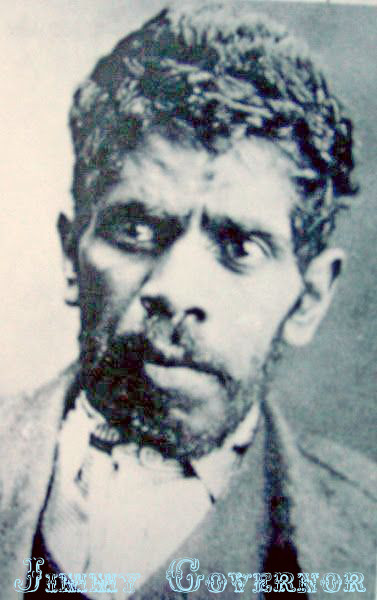
The marker consists of a larger bronze plaque mounted on a circular plinth with a smaller plaque above. The smaller plaque indicates that the the marker was erected to commemorate the centenary of the capture of outlaw Jimmy Governor on October 27th, 1900, and was placed by the Manning Valley Historical Society in October of 2000.
The larger plaque indicates that Governor was captured on this spot by eight individuals, Messrs A. Cameron, T. Green, J. McPherson, J. Wallace, W. Moore. F. Moore, T. Moore and T. Moore Jr.

Jimmy Governor was an exploited Aborigine who had experienced much discrimination in his life and eventually turned to murder as a result of his most recent degrading experience. Jimmy and his friend Jacky Underwood (aka Charlie Brown) murdered four members of his employer's family on July 20th, 1900 at Breelong, near Gilgandra. Jacky Underwood was soon caught, but Jimmy and his brother Joe escaped and fled Breelong, committing four more murders while running east towards the coast. Jimmy was shot on October 13th and eventually caught on October 27th. Joe was shot dead four days later near Singleton. Jimmy was hanged on January 14, 1901. Jackie Underwood had been hung four days prior.
Read Jimmy's biography below.
Jimmy Governor
Jimmy Governor (1875-1901), outlaw, was born on the Talbragar River, New South Wales, son of Sam (later Thomas) Governor (or Grosvenor), bullock-driver, and his wife Annie, née Fitzgerald. He received his schooling at a mission school and at Gulgong. Short, good-looking and part-Aboriginal with reddish hair, Jimmy worked at Wollar before becoming a police tracker at Cassilis from 15 July 1896 to 18 December 1897. He returned to Wollar and, after woodcutting at Gulgong and wool-rolling at Digilbar, married on 10 December 1898 Ethel Mary Jane Page, a 16-year-old white woman, at the Church of England rectory, Gulgong.
In April 1900, after a variety of jobs, Jimmy got a contract for fencing (splitting and erecting posts earning 10s. and 12s. a hundred respectively) from John Thomas Mawbey at Breelong, near Gilgandra. Conscientious and anxious to prove himself in white society, Jimmy was on good terms with his employer, obtaining his rations from him and playing cricket with his small sons. Jimmy and Ethel were joined by his brother Joe and Jacky Underwood (alias Charlie Brown), a full blood, who both helped in the work, and later by Jacky Porter, another full blood, and Jimmy's nephew Peter Governor. All claimed rations from Jimmy Governor.
Strains emerged in the marriage. Ethel, who did housework for the Mawbeys, grew unhappy; after a dispute with Mawbey, Jimmy and his friends talked of taking up bushranging. Touchy about his colour, Jimmy was stung by reports that Mrs Mawbey and Helen Josephine Kerz, a schoolteacher who lived with the Mawbeys, had taunted his wife for marrying a blackfellow. With Underwood he confronted the women, who were alone in the house with seven children and Mrs Mawbey's 18-year-old sister Elsie Clarke, on the night of 20 July 1900. Jimmy alleged that the women laughed at him and Helen Kerz said: 'Pooh, you black rubbish, you want shooting for marrying a white woman'. Losing all control, the two, with nulla-nullas and tomahawk, killed Mrs Grace Mawbey, Helen Kerz, and Grace (16), Percival (14) and Hilda Mawbey (11); Elsie Clarke was seriously injured.
Underwood was quickly caught but Jimmy and Joe Governor, calling themselves 'bushrangers', went on a fourteen-week, 2000-mile (3219 km) rampage, terrorizing a wide area of north-central New South Wales. Seeking revenge on persons who had wronged them, they killed Alexander McKay near Ulan on 23 July, Elizabeth O'Brien and her baby son at Poggie, near Merriwa, on 24 July, and Keiran Fitzpatrick near Wollar, on 26 July. After committing numerous robberies as far north as Narrabri, and in the Quirindi district, they moved into the rugged headwater country of the Manning and Hastings rivers, pursued by Queensland black trackers, bloodhounds and hundreds of police and civilians. Exulting in outwitting their pursuers, the Governors blatantly broadcast their whereabouts and wrote derisive notes to the police. On 8 October the government offered a reward of £1000 each for their capture.
After several close escapes Jimmy was shot in the mouth by Herbert Byers, a hunter, on 13 October; in a weakened condition he was captured by a party of settlers at Bobin, near Wingham, on 27 October. Joe was shot dead by John Wilkinson north of Singleton on 31 October. They had been outlawed on 23 October.
Jimmy stood trial on 22-23 November in Sydney for the murder of Helen Kerz. He was defended by Francis Stewart Boyce who raised the defence of autrefois aquit and autrefois attaint, arguing that as a result of outlawry Governor had already been attainted and could not be tried for the same crimes. These pleas in bar of trial were rejected and Governor was convicted. An appeal was dismissed, and he spent his last days reading the Bible, singing native songs and blaming his wife. He was hanged at Darlinghurst Gaol on 18 January 1901 and buried in an unmarked grave in the Anglican section of Rookwood cemetery; Underwood had been hanged in the Dubbo gaol four days before. Governor was survived by his wife and son; on 23 November Ethel Governor married Francis Joseph Brown by whom she had nine more children. She died in Sydney on 31 December 1945.
Jimmy Governor's ravages, in the context of Aboriginal dispossession and white racism, were the subject of Thomas Keneally's novel The chant of Jimmy Blacksmith (1972), which was made into a film in 1978.
From the Australian Dictionary of Biography